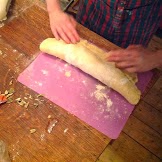As an adult though, I've come to love the tart contrast with roast turkey and game. It was always a production to make - my mother would get out our old-fashioned food-grinder that was screwed on to the table top, and the whole family would join in the hard work.
Just after I moved to the UK, Delia introduced cranberries over here, but everyone seemed to make jelly, which I find bland. Luckily, with cranberries now available in the shops, I was able to reinvent the family relish, despite not having the food-grinder.
It turns out that any sort of food-processor works just fine. For years, we used our immersion blender, but we now have a mini food-processor. The recipe is very simple - one bag cranberries (fresh or frozen) - pick over and take out any that are brown or very wrinkled. The proportions are rough, so don't worry too much about the size of bag. One average sized orange, washed and roughly chopped (peel, pith and all). In small batches, blend the cranberries and orange together until well chopped, but not pureed.
Then add 1 cup (200 gr) granulated or caster sugar (in volume terms, this is about 1 part sugar to two parts cranberries). Mix well, and let sit to macerate, then refrigerate.
Ideally, this is made a few days before it it needed to let the flavours blend, but at a pinch, even just a couple of hours will do.













.JPG)


.JPG)











.JPG)


.JPG)

.JPG)

